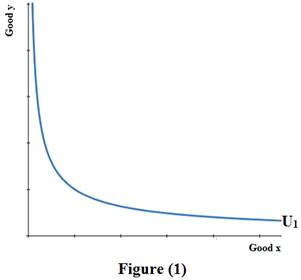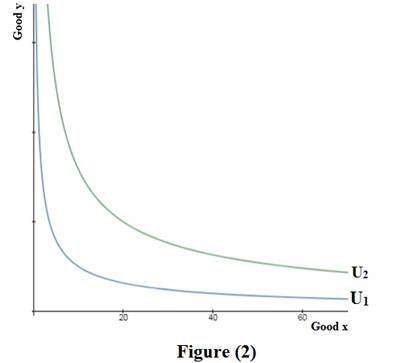
(a)
Whether the assumption 'more is better' satisfied for both the goods, x and y or not.
Explanation of Solution
The consumer prefers two goods x and y.
The utility function of the consumer is given as follows-
Also,
The additional utility derived from the consumption of additional unit of good is known as marginal utility.
Since, MUx > 0 and MUy> 0. The assumption that more is better is satisfied for both the goods.
(b)
Whether the marginal utility of good x diminishes, remain constant, or increase as the consumer buys more units of good x.
Explanation of Solution
Differentiate (1) with respect to x to determine whether the marginal utility good x diminishes, remain constant, or increase as the consumer buys more units of good x.
As,
Thus, it can be concluded that marginal utility of good x diminishes as the consumer buys more units of good x.
(c)
Marginal rate of substitution of the two goods, x and y.
Explanation of Solution
The rate at which consumer is willing to sacrifice some units of good x to get an additional unit of good y is known as marginal rate of substitution (MRS).
MRSx,y, is equal to the ratio of the marginal utility of good x to the marginal utility of good y.
(d)
Whether marginal rate of substitution of the two goods, x and y diminishes, remain constant, or increase as the consumer substitutes x for y along an indifference curve.
Explanation of Solution
Differentiate (3) with respect to x to determine whethermarginal rate of substitution of the two goods, x and y diminishes, remain constant, or increase as the consumer substitutes x for y along an indifference curve.
As,
Thus, it can be concluded that marginal rate of substitution of the two goods, x and y diminishes, as the consumer substitutes x for y along an indifference curve.
(e)
A typical indifference curve of the given utility function. And whether the curve intersects X-axis or Y-axis or not.
Explanation of Solution
The figure (1) below depicts a typical indifference curve U1. The declining slope of the curve represents diminishing MRSx, y.

The indifference curve U1 does not intersect either axis.
(f)
The second indifference curve U2, with U2> U1.
Explanation of Solution
The figure (2) below represents second indifference curve U2. Here, U2 >U1.

Since U2 lies above U1,U2 represents higher level of satisfaction. Thus, U2 >U1. A consumer always prefers higher indifference curves.
Want to see more full solutions like this?
Chapter 3 Solutions
EBK MICROECONOMICS
- Discuss the impact of exchange rate volatility on the economy and its impact on your organisation. Make use of the relevant diagrams.arrow_forwardMacroeconomic policies have different effects on the price level and output (national income). Discuss the impact of a monetary policy that seeks to encourage economic growth.arrow_forwardCan you please help with this one. Some economists argue that taxing consumption is more efficient than taxing income. Following the same argument, the minister of finance of a country introduced a new tax for sugar based products “sugar tax” to promote healthy eating in the economy. Please use relevant diagrams to explain the impact of the tax on consumers, producers and the tax revenue when sugar is elastic and inelastic.arrow_forward
- profit maximizing and loss minamization fire dragon co mindtaparrow_forwardProblem 3 You are given the following demand for European luxury automobiles: Q=1,000 P-0.5.2/1.6 where P-Price of European luxury cars PA = Price of American luxury cars P, Price of Japanese luxury cars I= Annual income of car buyers Assume that each of the coefficients is statistically significant (i.e., that they passed the t-test). On the basis of the information given, answer the following questions 1. Comment on the degree of substitutability between European and American luxury cars and between European and Japanese luxury cars. Explain some possible reasons for the results in the equation. 2. Comment on the coefficient for the income variable. Is this result what you would expect? Explain. 3. Comment on the coefficient of the European car price variable. Is that what you would expect? Explain.arrow_forwardProblem 2: A manufacturer of computer workstations gathered average monthly sales figures from its 56 branch offices and dealerships across the country and estimated the following demand for its product: Q=+15,000-2.80P+150A+0.3P+0.35Pm+0.2Pc (5,234) (1.29) (175) (0.12) (0.17) (0.13) R²=0.68 SER 786 F=21.25 The variables and their assumed values are P = Price of basic model = 7,000 Q==Quantity A = Advertising expenditures (in thousands) = 52 P = Average price of a personal computer = 4,000 P. Average price of a minicomputer = 15,000 Pe Average price of a leading competitor's workstation = 8,000 1. Compute the elasticities for each variable. On this basis, discuss the relative impact that each variable has on the demand. What implications do these results have for the firm's marketing and pricing policies? 2. Conduct a t-test for the statistical significance of each variable. In each case, state whether a one-tail or two-tail test is required. What difference, if any, does it make to…arrow_forward
- You are the manager of a large automobile dealership who wants to learn more about the effective- ness of various discounts offered to customers over the past 14 months. Following are the average negotiated prices for each month and the quantities sold of a basic model (adjusted for various options) over this period of time. 1. Graph this information on a scatter plot. Estimate the demand equation. What do the regression results indicate about the desirability of discounting the price? Explain. Month Price Quantity Jan. 12,500 15 Feb. 12,200 17 Mar. 11,900 16 Apr. 12,000 18 May 11,800 20 June 12,500 18 July 11,700 22 Aug. 12,100 15 Sept. 11,400 22 Oct. 11,400 25 Nov. 11,200 24 Dec. 11,000 30 Jan. 10,800 25 Feb. 10,000 28 2. What other factors besides price might be included in this equation? Do you foresee any difficulty in obtaining these additional data or incorporating them in the regression analysis?arrow_forwardsimple steps on how it should look like on excelarrow_forwardConsider options on a stock that does not pay dividends.The stock price is $100 per share, and the risk-free interest rate is 10%.Thestock moves randomly with u=1.25and d=1/u Use Excel to calculate the premium of a10-year call with a strike of $100.arrow_forward
 Economics (MindTap Course List)EconomicsISBN:9781337617383Author:Roger A. ArnoldPublisher:Cengage Learning
Economics (MindTap Course List)EconomicsISBN:9781337617383Author:Roger A. ArnoldPublisher:Cengage Learning


 Exploring EconomicsEconomicsISBN:9781544336329Author:Robert L. SextonPublisher:SAGE Publications, Inc
Exploring EconomicsEconomicsISBN:9781544336329Author:Robert L. SextonPublisher:SAGE Publications, Inc





